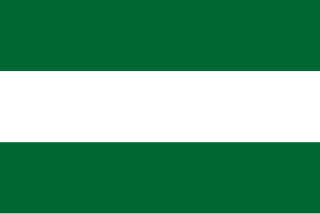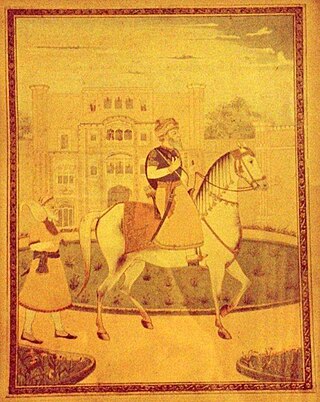
The Durrani Empire or the Afghan Empire, also known as the Sadozai Kingdom, was an Afghan empire that was founded by Ahmad Shah Durrani in 1747, that spanned parts of Central Asia, the Iranian plateau, and the Indian Subcontinent. At its peak, it ruled over the present-day Afghanistan, much of Pakistan, parts of northeastern and southeastern Iran, eastern Turkmenistan, and northwestern India. Next to the Ottoman Empire, the Durrani Empire is considered to be among the most significant Islamic Empires of the 18th century.

Hari Singh Nalwa was Commander-in-chief of the Sikh Khalsa Fauj, the army of the Sikh Empire. He is known for his role in the conquests of Kasur, Sialkot, Attock, Multan, Kashmir, Peshawar and Jamrud. Hari Singh Nalwa was responsible for expanding the frontier of Sikh Empire to beyond the Indus River right up to the mouth of the Khyber Pass. At the time of his death, the western boundary of the empire was Jamrud.

Sultan-ul-Qaum Sardar Jassa Singh Ahluwalia was a Sikh leader during the period of the Sikh Confederacy, being the Supreme Leader of the Dal Khalsa. He was also Misldar of the Ahluwalia Misl. This period was an interlude, lasting roughly from the time of the death of Banda Bahadur in 1716 to the founding of the Sikh Empire in 1801. He founded the Kapurthala State in 1772.

Sardar Jhanda Singh was a Chief of Bhangi Misl Under his leadership the Misl Dar family became the dominant de facto ruling power of Punjab. His father was Sardar Hari Singh, one of the most powerful Sikh warriors of the time. He also had a warrior brother Ganda Singh Dhillon. Jhanda Singh had appointed his younger brother Sardar Ganda Singh as the commander in chief of his forces. Jassa Singh Ramgarhia was one of the closest friends of Jhanda Singh.

Sardar Charat Singh, also romanised as Charhat Singh, was the founder of Sukerchakia Misl and father of Mahan Singh, and the grandfather of Ranjit Singh. He distinguished himself at an early age in campaigns against Ahmad Shah Abdali and along with 150 horsemen split from the Singhpuria Misl to establish the Sukerchakia Misl.

The Battle of Attock took place on 13 July 1813 between the Sikh Empire and the Durrani Empire. The battle was the first significant Sikh victory over the Durranis.
The siege of Multan began in March 1818 and lasted until 2 June 1818 as part of the Afghan–Sikh Wars, and saw the Sikh Empire capture the city of Multan from the Durrani Empire.

The Afghan–Sikh wars spanned from 1748 to 1837 in the Indian subcontinent, and saw multiple phases of fighting between the Durrani Empire and the Sikh Empire, mainly in and around Punjab region. The conflict's origins stemmed from the days of the Dal Khalsa, and continued after the Emirate of Kabul succeeded the Durrani Empire.

Timur Shah Durrani, also known as Timur Shah Abdali or Taimur Shah Abdali was the second ruler of the Afghan Durrani Empire, from November 1772 until his death in 1793. An ethnic Pashtun, he was the second eldest son of Ahmad Shah Durrani.

Nawab Muzaffar Khan was the last Afghan governor of Multan.
The Battle of Kup was fought on 5 February 1762, between the Afghan forces of Ahmad Shah Durrani and the Sikhs, under the command of Jassa Singh Ahluwalia and Charat Singh. Ahmad Shah Durrani and the Afghan forces reached Malerkotla, west of Sirhind. Different sources give various estimates on how many sikhs were present. According to Tom Landsford, nearly 30,000 Sikh men, women, children, and elderly laid encamped. According to Narendra Sinha, 40,000 Sikhs were present. According to Hari Ram Gupta, 50,000 Sikh soldiers laid encamped at Kup while 5,000 non combatants laid encamped at Pind Garma. Abdali's forces outnumbered the Sikhs in hand-to-hand combat and the Sikhs couldn't use their usual tactics of hit and run, but had to engage in battle while protecting the civilians at the same time. With surprise attack, the Sikhs threw a human ring around civilians as protection and fought the battle killing several thousand Afghans. Abdali was able to break the ring and carried out a full scale massacre of the Sikh civilians. Ahmad Shah's forces killed several thousand Sikhs, and the surviving Sikhs fled to Barnala. According to various different estimates, as many as 5,000 to 30,000 Sikh men, women, elderly and children were killed in what is known as the second Sikh genocide.

Ahmad Shah Durrani, the founder of the Durrani Empire, invaded Indian subcontinent for eight times between 1748 and 1767, following the collapse of Mughal Empire in the mid-18th century. His objectives were met through the raids and deepened the political crisis in India.

The Battle of Amritsar, also known as the Battle of Gohalwar, was fought between the Durrani Empire and Shaheedan Misl of the Dal Khalsa on 11 November 1757. Following the fourth invasion of Ahmad Shah Durrani, his army was attacked by Sikh bands under the command of Ala Singh and Baba Deep Singh. Following the attacks, Ahmad Shah desecrated the Sikh holy site known as the Shri Harmandir Sahib in Amritsar. The news of the desecration reached Baba Deep Singh who vowed to liberate the holy site from the Afghans. This resulted in a pitched battle being fought in the village of Gohalwar, near Amritsar. The battle resulted in Baba Deep Singh being killed and an Afghan victory.

The Battle of Rohtas took place somewhere in December 1779, between Timur Shah Durrani and the Bhangi Misl. Timur Shah consolidated his rule through multiple attempts, and also attempted an earlier invasion in 1775, however realizing the weakness of his army in view of smaller in number, Timur Shah retired to Peshawar which proceeded with rebellion by Faizullah Khan, who plotted to assassinate Timur Shah but was cunningly executed. In late 1779, Timur Shah decided to conquer Multan.
Shuja Khan was an Afghan governor of Multan in the 18th century. He was father of Nawab Muzaffar Khan. Nawab Shuja Khan, the second son of Nawab Zahid Khan, who twice remained the governor (Subedar) of Multan under Ahmed Shah Durrani's rule. Nawab Shuja Khan founded the Shujabad town in 1750 and built the fortification wall between 1767 and 1772. Nawab Shuja Khan died in 1775 AD. He was buried outside Basti Khairpur.
The Battle of Mahilpur was fought between the Sikh Misls and Adina Beg Khan against the Durrani Empire in December 1757.Following the 4th invasion of Ahmad Shah Durrani, he would appoint Timur Shah as the viceroy of Punjab with Jahan Khan as his deputy.The Afghans would appoint Adina Beg Khan as the faujdar of the Jalandhar Doaba and exempted him from attending court at lahore, on the condition that Adina Beg pay revenue to the Afghan government.Soon a dispute regarding the payment of revenue occurred between Adina Beg and the Afghans.This dispute soon escalated which resulted in Jahan Khan sending an Afghan force to arrest Adina Beg.Adina Beg formed a military alliance with the Sikhs under the command of Jassa Singh Ahluwalia and Vadbhag Singh Sodhi.Adina Beg also gained the support of Sadiq Beg Khan, Khwaja Mirza Khan, and Raja Bhup Singh.Adina Beg along with the Sikh forces fought the Afghans at Mahilpur.The battle resulted in a victory for Adina Beg and the Sikhs and resulted in the entire Jalandhar Doaba being occupied and sacked by the Sikh forces.
The Battle of Shujabad took place in February 1780, during the Afghan–Sikh Wars. The Afghans were led by Muzaffar Khan and Timur Shah Durrani, while the Sikhs were led by Jassa Singh Ahluwalia and other Sikh chiefs.
The Battle of Lahore was fought between Afghan forces under Ahmad Shah Durrani and Mughal forces under Shah Nawaz on 11 January 1748. Zakriya Khan, the Mughal Governor of Lahore, died in 1745 and was succeeded by his son, Yahya Khan. Yahya Khan's governorship over Lahore was soon challenged by his brother, Shah Nawaz, who was the governor of Multan. This resulted in a war between the two brothers, lasting from November 1746 to March 1747. The war was won by Shah Nawaz, who soon usurped the governorship of Lahore. Shah Nawaz would go on to appoint Kaura Mal as his diwan and recognized Adina Beg Khan as the Faujdar of the Jalandhar Doaba. Shah Nawaz used his captive brother as a bargaining tool in order to get recognition from the Delhi government. However, following Yahya Khan's escape from captivity, Shah Nawaz sought help from abroad. He turned to Ahmad Shah Durrani, who had just taken the city of Kabul from the Mughals. Ahmad Shah agreed to assist him, and left Peshawar in December 1747. However, Shah Nawaz then changed his allegiance back to the Mughals, and fought a battle against Ahmad Shah near Lahore. The battle was won by the Afghans, who briefly occupied the city of Lahore.
The siege of Multan was a battle fought between the Sikh forces led by Jhanda Singh Dhillon and the Afghan forces led by Shuja Khan.
The Battle of Sialkot was fought in January 1789 by the Sikh forces led by Natha Singh and Afghan forces led by Timur Shah Durrani.












